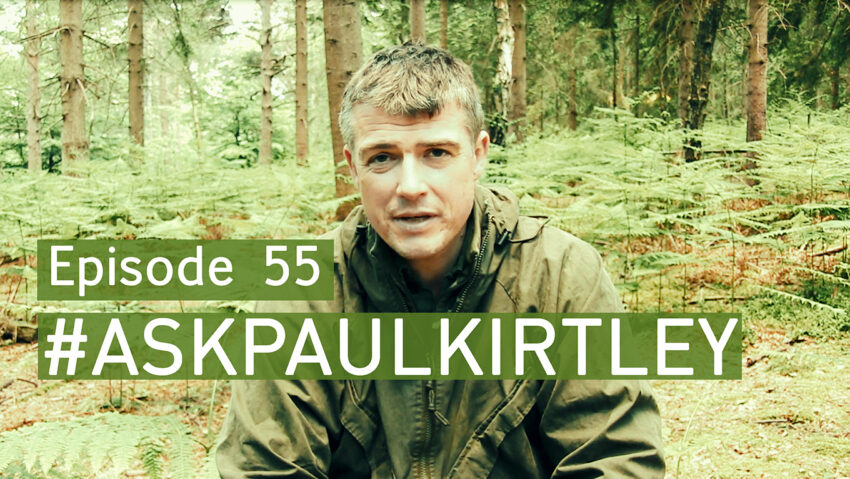
#AskPaulKirtley Episode 55 – Longevity of Pathogenic Organisms, Magnifying Glass Specifications, Branches Dropping, Umbrellas, Resin Content in Bow-drills…
In this episode of #AskPaulKirtley I answer your questions about shorts for hiking and camp, the longevity of pathogenic organisms in water containers, magnifying glass specifications for fire lighting, the danger of branches dropping in woodland and checks to make before setting camp, the value of umbrellas for bushcraft and camping, resin content in bow-drill materials, particularly balsam fir…
Watch #AskPaulKirtley
The video above is ad-free. If you particularly enjoy it, or gain value from it, consider buying me a coffee to help support the video hosting for these ad-free videos. Thanks!
#AskPaulKirtley videos are also available to view on my YouTube channel.
Listen To #AskPaulKirtley
Use the following controls to listen to the audio podcast right here or download the .mp3 to your device…
How To Listen To #AskPaulKirtley On Other Platforms
Podcast RSS Feed: You can subscribe via the #AskPaulKirtley Podcast RSS Feed
iTunes: You can subscribe to #AskPaulKirtley via iTunes
Soundcloud: Follow me on here on Soundcloud
Leave A Comment…
Leave me a comment below. Let me know what you think of this episode. I read every one.
But remember if you want to ask a question for a future episode, don’t do this in the comments below, do it in one of the ways explained HERE.
What Is #AskPaulKirtley?
#AskPaulKirtley is my Q&A video and podcast series that aims to answer your questions about bushcraft, survival skills and outdoor life.
The idea here is partly to take the strain off my email inbox and get answers out to people in a more timely fashion.
Rather than send an answer to just that one person, I’d like others to benefit from the answers too. So, just in the same way I’d previously write an email answer, here I’m going to speak the answer (which is much quicker than me typing out an answer, so I’ll get more questions answered as well as benefiting more people).
Click here to find out the different ways you can ask me a question.
Related Material On Paul Kirtley’s Blog:
Bow Drill: The Keys To Success
Water Purification: The Five Contaminants You Need To Know About
#AskPaulKirtley Episode 39 – Wilderness Water Sources & Water Purification

5 thoughts on “#AskPaulKirtley Episode 55 – Longevity of Pathogenic Organisms, Magnifying Glass Specifications, Branches Dropping, Umbrellas, Resin Content in Bow-drills…”
Camping under trees:
I would be wary of camping under any tree that looks as if it may have been pollarded in the past. Pollarding can introduce a structural weakness in the tree, and perhaps make branches more prone to splitting out.
In the UK, pollards are common in hedgerows, along river banks and in ancient woodland. They also occur within commercial forestry, usually along old boundaries.
Pollards are trees that have been “beheaded” at some time in the past, often many times. This was done to utilise the regrowth as withies, fuel, fodder, or for numerous other reasons.
Pollards can often be easily recognised as they have a number of branches of similar age arising from the same point on the trunk. It is this habit that may make them structurally unsound.
Oak was often polllarded. Most ancient oaks in the eastern counties appear to have been poIlarded at some point.
I live on the Fens, where the the most copmmon pollard is willow. Indeed, almost all willow trees on the fens appear to have been pollarded at some point.
I would welcome any further useful comments about pollards – particularly on those species that that tend to occur as pollards in your local area.
Hi Bob, good to have you back here and thanks for your comments regarding pollards – an interesting addition to the conversation.
Warm regards,
Paul
Hi Paul another great podcast. I was thinking about choosing the best magnifying glass and in addition to the comments you made I would say focal length is important. Some have a rediculously small focal length so you have to get to close to where you want to focus the light. Secondly if the focal length is too long it is more difficult to keep the light focused in a small area. In places with weaker or limited amounts of sunlight this can cause problems, and the need for steadier hands. Castle
Good points. Thanks for sharing your thoughts.
Warm regards,
Paul
Hi Paul!
I left Berlin some mons ago, so i cant be sure, whats about it today, but in the end of April it was still german, and not Austrian! :0)
I bought that Snugpack SF bivi bag as you know, but used it only in conditions around O*C and so I used a military poncho when it was raining, as lean to shelter I was surprised how good it kept me dry. It seemes to transport moisture through the fabric as good as Goretex.
Now I was for weeks in France (and always playing with low budget stuff )using that Decathlon Arpenaz 2 tent to try it out and it is for beginners in settled areas a very good recommendation. 20 € is an incredible low price for such a good tent. Ok, no Rain protected entrance but self carrying structure, 2kg without pegs. Strong groundsheed. A great offer! Grass green and great!
And so I am looking forward to risk that summer SF bivi solo without umbrella! :0)
Last time a friend of mine who is older than 60 told me he would use on hikes only umbrellas and no Ponchos or Rainjackets any more, seriously. In the very beginning of the german hiking moovement Wandervogel they had been a lot in use, to protect the small flame of Spiritus or Esbit burners too.
May bee they will come back? Surely it would be very British to do that!